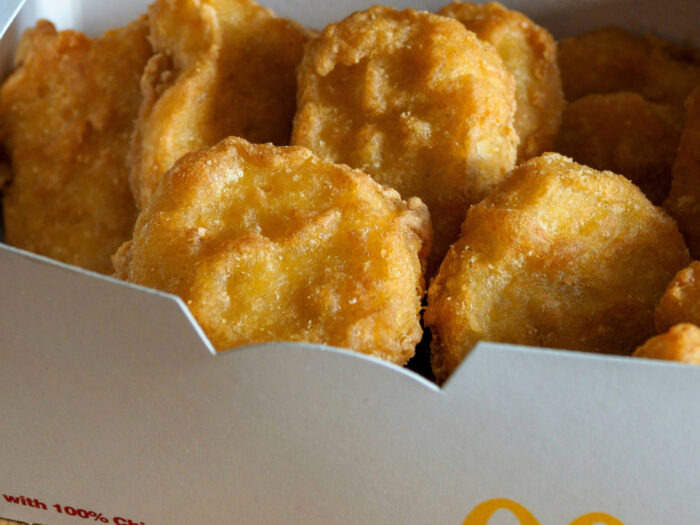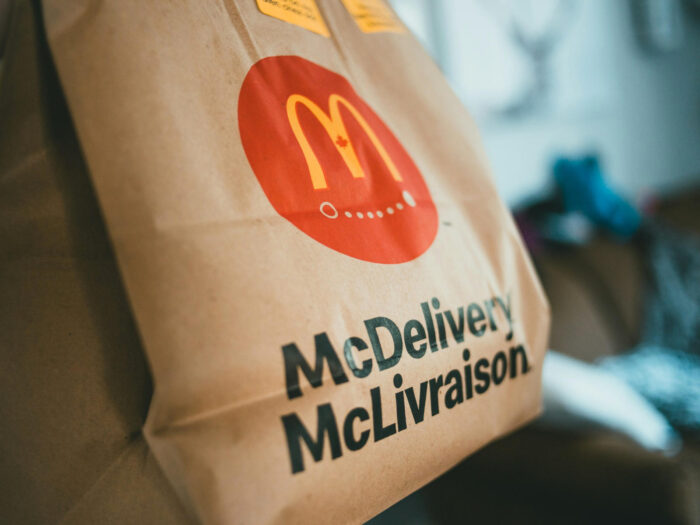
McDonald’s marketing mix (4Ps) meets business objectives in different markets around the world. The company’s product, place, promotion, and price (4P) strategies and tactics apply to company-owned and franchise locations.
This marketing mix defines the strategies and tactics that McDonald’s uses in executing its marketing plan and achieving related marketing strategy goals to grow the multinational fast-food restaurant chain.
McDonald’s marketing mix contributes to brand strength and competitiveness despite the effective 4Ps and marketing strategies of competitors, like Burger King, Wendy’s, Dunkin’, and Subway, as well as other foodservice firms that compete with McCafé, such as Starbucks and Tim Hortons.
This marketing mix supports the company’s global industry position while managing the impacts of such competitive rivalry defined in the Five Forces analysis of McDonald’s. The 4P ensures a profitable connection with target customers.
McDonald’s Products
McDonald’s product mix is composed mainly of food and beverage products. This element of the marketing mix covers the company’s organizational outputs (goods and services) for its target markets. McDonald’s products are:
- Hamburgers and sandwiches
- Chicken and fish
- Salads
- Snacks and sides
- Beverages
- Desserts and shakes
- Breakfast/All-day breakfast
- McCafé
Among the 4Ps, burgers and fries are the products strongly associated with McDonald’s brand and corporate image. However, considering product mix diversification, consumers can also purchase other products, like chicken and fish, desserts, and breakfast meals.
McDonald’s generic competitive strategy and intensive growth strategies influence the product lines included in this element of the marketing mix. For example, the product development strategy leads to a diverse product mix for the foodservice market.
In diversifying its product lines, McDonald’s satisfies market demand and improves its revenues. In terms of risk, a more diverse product mix reduces the company’s dependence on just one or a few foodservice market segments.
This element of McDonald’s marketing mix indicates innovation for new products and product variants to attract more customers, increase market share, and improve business competitiveness and stability.

Price in McDonald’s Marketing Mix
This element of the marketing mix specifies price points and price ranges for the company’s food and beverage products. These prices maximize profit margins and sales volume. McDonald’s 4P uses a combination of the following pricing strategies:
- Bundle pricing strategy
- Psychological pricing strategy
In bundle pricing, McDonald’s offers meal sets and other product bundles for prices that are discounted, compared to purchasing each menu item separately. For example, customers can purchase a Happy Meal for optimal cost and product value.
On the other hand, in psychological pricing, McDonald’s marketing mix uses prices that appear more affordable, such as $__.99 for a meal instead of rounding the price off to the nearest dollar. This pricing strategy is especially common in foodservice business.
This application of psychological pricing encourages consumers to buy McDonald’s food and beverage products and dine at the company’s restaurants based on perceived affordability or value for money.
This element of McDonald’s marketing mix highlights the effectiveness of combining bundle pricing and psychological pricing in encouraging customers to buy more of the company’s products.
The cost objectives and limits and productivity requirements applied in McDonald’s operations management account for the pricing targets based on the pricing strategies included in this marketing mix.
McDonald’s Promotion
This element of McDonald’s marketing mix defines tactics focusing on marketing communications with target customers. With its promotional mix, McDonald’s uses the following tactics for this 4P element:
- Advertising (most significant)
- Sales promotions
- Public relations
- Direct marketing
Advertisements are the most visible promotion in McDonald’s marketing strategy. The corporation uses online media, TV, radio, billboards, and print media for its advertisements. This multichannel approach ensures maximum market reach.
On the other hand, sales promotions are used to draw more customers to the company’s restaurants. For example, McDonald’s offers discount coupons, freebies, and special deals and offers for certain products and product bundles, as a way of attracting more consumers.
In addition, the company’s marketing mix involves public relations to promote the fast-food business to target markets through goodwill and brand strengthening related to McDonald’s CSR and ESG strategy for stakeholders.
For example, donations from the company and its franchisees and customers support Ronald McDonald House Charities (RMHC). This support for RMHC advocates community interests and boosts the value of the company’s brands.
The company’s promotional mix uses direct marketing, such as for corporate clientele, local governments, or community organizations and events and parties. Franchisees directly promote their products and foodservice to these target clients.
In this element of its marketing mix, McDonald’s emphasizes advertising as its main approach to promoting its products. The other promotional tactics complement advertisements for persuading consumers to keep buying McDonald’s products.
Branding and other business competitive advantages specified in the SWOT analysis of McDonald’s contribute to the effectiveness of promotional activities in this marketing mix element.

Place in McDonald’s 4Ps
This marketing mix element enumerates venues/locations for product distribution to customers. Restaurants are prominent but other places are involved in the company’s distribution strategy. The places/channels in McDonald’s 4P include:
- Restaurants
- Kiosks
- McDonald’s websites and mobile apps
- Third-party websites, mobile apps, and others
- Retailers
McDonald’s restaurants are where the company generates most of its sales revenues. Some of these restaurants also manage kiosks to sell a limited selection of products, such as sundae and other desserts.
Some kiosks are temporary, as in the case of kiosks used in professional sports competitions and other seasonal events. Other kiosks operate longer as extensions of existing franchise restaurant locations.
This element of McDonald’s marketing mix also involves the company’s websites and mobile apps. These virtual places are where customers can access information about the company’s food products and buy these products.
For example, the company’s mobile apps for iOS and Android let customers claim special deals, find restaurant locations, place orders, and pay for such orders involving participating McDonald’s restaurants.
Furthermore, McDonald’s customers can place their orders through third-party websites and mobile apps. This marketing mix includes third-party delivery service providers to seamlessly work with franchise locations.
McDonald’s products, such as McCafé ground coffee, are also available at Walmart, Costco, and other retailers. These retailers’ brick-and-mortar and online channels add to the extensive market reach achieved through McDonald’s marketing mix.
This element of the marketing mix maximizes market reach through various places for product distribution and foodservice provision. However, brick-and-mortar locations are the primary places, considering the nature of McDonald’s products.
The resulting maximized market reach aligns with McDonald’s mission statement and vision statement, especially in terms of the strategic goal of serving more customers in the global market.
References
- Eze, F. J., Inyang, I. B., & James, E. E. (2024). Standardization versus adaptation of marketing mix in international markets: A systematic literature review. World Journal of Advanced Research and Reviews, 22(2), 1192-1212.
- Lee, Y. Y., Kee, D. M. H., Ang, V. W. N., Laneishwar, A., Vehlan, L. S. S. V., Lee, L. X., … & Ardel, M. R. (2024). Golden Arches going green: The impact of McDonald’s sustainability achievements on public image. Advances in Global Economics and Business Journal, 5(1), 27-43.
- McDonald’s Corporation – Exclusive Deals.
- McDonald’s Corporation – Form 10-K.
- McDonald’s Corporation – Full Food Menu.
- McDonald’s Corporation – Mobile Ordering.
- Merz, M. A. (2025). International Marketing: Strategy and Theory. Taylor & Francis.
- U.S. Department of Agriculture – Economic Research Service – Food Service Industry Market Segments.